Study to Investigate the Potential of Combined Extract of Leaves and Seeds of Moringa oleifera in Groundwater Purification
Abstract
1. Introduction
2. Materials and Methods
2.1. Reagents
2.2. Water Sample (Groundwater)
2.3. Preparation of Plant Extract
2.4. Extraction Procedure by Soxhlet Apparatus
2.5. Coagulation Procedure Using Flocculator Apparatus
2.6. Comparative Analysis of Physicochemical Parameters in Groundwater
2.6.1. Physicochemical Parameters
2.6.2. Metallic Impurities
2.7. Biological Parameter (Escherichia coli) Analysis
2.8. Statistical Analysis
3. Results
3.1. Effect of the Moringa oleifera Plant Extract on pH
3.2. Effect of the Moringa oleifera Plant Extract on TDS
3.3. Effect of Moringa oleifera Plant Extract on Total Hardness
3.4. Effect of Moringa oleifera Plant Extract on Turbidity
3.5. Effect of Moringa oleifera Plant Extract on Metallic Impurity
3.6. Effect of the Moringa oleifera Plant Extract on Biological Contaminant (E. coli)
4. Discussion
5. Conclusions
Author Contributions
Funding
Acknowledgments
Conflicts of Interest
References
- Pal, M.; Ayele, Y.; Hadush, M.; Panigrahi, S.; Jadhav, V.J. Public health hazards due to unsafe drinking water. Air Water Borne Dis. 2018, 7, 2. [Google Scholar]
- Mahmood, A.; Mahmoud, A.H.; El-Abedein, A.I.Z.; Ashraf, A.; Almunqedhi, B.M. A comparative study of metals concentration in agricultural soil and vegetables irrigated by wastewater and tube well water. J. King Saud Univ. Sci. 2020, 32, 1861–1864. [Google Scholar] [CrossRef]
- Santonastaso, G.F.; Erto, A.; Bortone, I.; Chianese, S.; Di Nardo, A.; Musmarra, D. Experimental and simulation study of the restoration of a thallium (I)-contaminated aquifer by Permeable Adsorptive Barriers (PABs). Sci. Total Environ. 2018, 630, 62–71. [Google Scholar] [CrossRef] [PubMed]
- Mohd-Salleh, S.N.A.; Mohd-Zin, N.S.; Othman, N. A review of wastewater treatment using natural material and its potential as aid and composite coagulant. Sains Malays. 2019, 48, 155–164. [Google Scholar] [CrossRef]
- Othmani, B.; Rasteiro, M.G.; Khadhraoui, M. Toward green technology: A review on some efficient model plant-based coagulants/flocculants for freshwater and wastewater remediation. Clean Technol. Environ. Policy 2020, 22, 1025–1040. [Google Scholar] [CrossRef]
- Ugwu, S.N.; Umuokoro, A.F.; Echiegu, E.A.; Ugwuishiwu, B.O.; Enweremadu, C.C. Comparative study of the use of natural and artificial coagulants for the treatment of sullage (domestic wastewater). Cogent Eng. 2017, 4, 1365676. [Google Scholar] [CrossRef]
- ELsayed, E.M.; Nour El-Den, A.A.; Elkady, M.F.; Zaatout, A.A. Comparison of coagulation performance using natural coagulants against traditional ones. Sep. Sci. Technol. 2020, 1–9. [Google Scholar] [CrossRef]
- Yin, C.Y. Emerging usage of plant-based coagulants for water and wastewater treatment. Process Biochem. 2010, 45, 1437–1444. [Google Scholar] [CrossRef]
- Abd El-Hack, M.E.; Alagawany, M.; Elrys, A.S.; Desoky, E.S.M.; Tolba, H.M.; Elnahal, A.S.; Swelum, A.A. Effect of forage Moringa oleifera L. (moringa) on animal health and nutrition and its beneficial applications in soil, plants and water purification. In Quality and Production of Forage; MDPI: Basel, Switzerland, 2019; p. 33. [Google Scholar]
- Gopalakrishnan, L.; Doriya, K.; Kumar, D.S. Moringa oleifera: A review on nutritive importance and its medicinal application. Food Sci. Hum. Wellness 2016, 5, 49–56. [Google Scholar] [CrossRef]
- Gupta, S.; Jain, R.; Kachhwaha, S.; Kothari, S.L. Nutritional and medicinal applications of Moringa oleifera Lam.—Review of current status and future possibilities. J. Herb. Med. 2018, 11, 1–11. [Google Scholar] [CrossRef]
- Padayachee, B.; Baijnath, H. An updated comprehensive review of the medicinal, phytochemical and pharmacological properties of Moringa oleifera. S. Afr. J. Bot. 2020, 129, 304–316. [Google Scholar] [CrossRef]
- Delelegn, A.; Sahile, S.; Husen, A. Water purification and antibacterial efficacy of Moringa oleifera Lam. Agric. Food Secur. 2018, 7, 25. [Google Scholar] [CrossRef]
- Moulin, M.; Mossou, E.; Signor, L.; Kieffer-Jaquinod, S.; Kwaambwa, H.M.; Nermark, F.; Rennie, A.R. Towards a molecular understanding of the water purification properties of Moringa seed proteins. J. Colloid Interface Sci. 2019, 554, 296–304. [Google Scholar] [CrossRef] [PubMed]
- Sulaiman, M.; Zhigila, D.A.; Mohammed, K.; Umar, D.M.; Aliyu, B.; Abd Manan, F. Moringa oleifera seed as alternative natural coagulant for potential application in water treatment: A review. J. Adv. Rev. Sci. Res. 2017, 30, 1–11. [Google Scholar]
- Shukla, P.; Tiwari, A.K.; Mishra, P. Study on Moringa oleifera Lam. Syn. Seed as a Ecofriendly Coagulant and Antimicrobial agent for Water Purification. Res. J. Sci. Technol. 2016, 8, 45–50. [Google Scholar] [CrossRef]
- Zaid, A.Q.; Ghazali, S.B.; Mutamim, N.S.A.; Olalere, O.A. Experimental optimization of Moringa oleifera seed powder as bio-coagulants in water treatment process. SN Appl. Sci. 2019, 1, 504. [Google Scholar] [CrossRef]
- Pandey, P.; Khan, F.; Ahmad, V.; Singh, A.; Shamshad, T.; Mishra, R. Combined efficacy of Azadirachta indica and Moringa oleifera leaves extract as a potential coagulant in ground water treatment. SN Appl. Sci. 2020, 2, 1300. [Google Scholar] [CrossRef]
- Pandey, P.; Khan, F.; Mishra, R.; Singh, S.K. Elucidation of the potential of Moringa oleifera leaves extract as a novel alternate to the chemical coagulant in water treatment process. Water Environ. Res. 2020, 92, 1051–1056. [Google Scholar] [CrossRef]
- Vara, S. Screening and evaluation of innate coagulants for water treatment: A sustainable approach. Int. J. Energy Environ. Eng. 2012, 3, 29. [Google Scholar] [CrossRef]
- Singh, D.D.; Thind, P.S.; Sharma, M.; Sahoo, S.; John, S. Environmentally sensitive elements in groundwater of an industrial town in India: Spatial distribution and human health risk. Water 2019, 11, 2350. [Google Scholar] [CrossRef]
- Adelodun, B.; Ogunshina, M.S.; Ajibade, F.O.; Abdulkadir, T.S.; Bakare, H.O.; Choi, K.S. Kinetic and Prediction Modeling Studies of Organic Pollutants Removal from Municipal Wastewater using Moringa oleifera Biomass as a Coagulant. Water 2020, 12, 2052. [Google Scholar] [CrossRef]
- WHO Guidelines for Drinking Water, Recommendations, World Health Organizations; WHO: Geneva, Switzerland, 2012.
- Saranya, P.; Ramesh, S.T.; Gandhimathi, R. Effectiveness of natural coagulants from non-plant-based sources for water and wastewater treatment—A review. Desalin. Water Treat. 2014, 52, 6030–6039. [Google Scholar] [CrossRef]
- Ang, W.L.; Mohammad, A.W. State of the art and sustainability of natural coagulants in water and wastewater treatment. J. Clean. Prod. 2020, 262, 121267. [Google Scholar] [CrossRef]
- Choy, S.Y.; Prasad, K.M.N.; Wu, T.Y.; Raghunandan, M.E.; Ramanan, R.N. Utilization of plant-based natural coagulants as future alternatives towards sustainable water clarification. J. Environ. Sci. 2014, 26, 2178–2189. [Google Scholar] [CrossRef] [PubMed]
- Shannon, M.A.; Bohn, P.W.; Elimelech, M.; Georgiadis, J.G.; Marinas, B.J.; Mayes, A.M. Science and technology for water purification in the coming decades. In Nanoscience and Technology: A Collection of Reviews from Nature Journals; World Scientific: Singapore, 2010; pp. 337–346. [Google Scholar]
- Yadav, M.; Gupta, R.; Sharma, R.K. Green and sustainable pathways for wastewater purification. In Advances in Water Purification Techniques; Elsevier: Amsterdam, The Netherlands, 2019; pp. 355–383. [Google Scholar]
- Gitis, V.; Hankins, N. Water treatment chemicals: Trends and challenges. J. Water Process Eng. 2018, 25, 34–38. [Google Scholar] [CrossRef]
- Zaman, S.; Begum, A.; Rabbani, K.S.; Bari, L. Low cost and sustainable surface water purification methods using Moringa seeds and scallop powder followed by bio-sand filtration. Water Sci. Technol. Water Supply 2017, 17, 125–137. [Google Scholar] [CrossRef]
- Nisha, R.R.; Jegathambal, P.; Parameswari, K.; Kirupa, K. Biocompatible water softening system using cationic protein from Moringa oleifera extract. Appl. Water Sci. 2017, 7, 2933–2941. [Google Scholar] [CrossRef]
- Baptista, A.T.A.; Silva, M.O.; Gomes, R.G.; Bergamasco, R.; Vieira, M.F.; Vieira, A.M.S. Protein fractionation of seeds of Moringa oleifera lam and its application in superficial water treatment. Sep. Purif. Technol. 2017, 180, 114–124. [Google Scholar] [CrossRef]
- Saini, R.K.; Sivanesan, I.; Keum, Y.S. Phytochemicals of Moringa oleifera: A review of their nutritional, therapeutic and industrial significance. 3 Biotech 2016, 6, 203. [Google Scholar] [CrossRef]
- Lin, M.; Zhang, J.; Chen, X. Bioactive flavonoids in Moringa oleifera and their health-promoting properties. J. Funct. Foods 2018, 47, 469–479. [Google Scholar] [CrossRef]
- Pandey, V.N.; Chauhan, V.; Pandey, V.S.; Upadhyaya, P.P.; Kopp, O.R. Moringa oleifera Lam.: A Biofunctional Edible Plant from India, Phytochemistry and Medicinal Properties. J. Plant Stud. 2019, 8. [Google Scholar] [CrossRef][Green Version]
- Zhao, Y.; Liu, R.; Awe, O.W.; Yang, Y.; Shen, C. Acceptability of land application of alum-based water treatment residuals–an explicit and comprehensive review. Chem. Eng. J. 2018, 353, 717–726. [Google Scholar] [CrossRef]
- Gandiwa, B.I.; Moyo, L.B.; Ncube, S.; Mamvura, T.A.; Hlabangana, N. Optimisation of using a blend of plant based natural and synthetic coagulants for water treatment: (Moringa oleifera -Cactus Opuntia-Alum Blend). S. Afr. J. Chem. Eng. 2020, 34, 158–164. [Google Scholar] [CrossRef]
- Saleem, M.; Hussain, A.; Mahmood, G. Analysis of groundwater quality using water quality index: A case study of greater Noida (Region), Uttar Pradesh (UP), India. Cogent Eng. 2016, 3, 1237927. [Google Scholar] [CrossRef]
- Tiwari, A.K.; Singh, A.K.; Mahato, M.K. Assessment of groundwater quality of Pratapgarh district in India for suitability of drinking purpose using water quality index (WQI) and GIS technique. Sustain. Water Resour. Manag. 2018, 4, 601–616. [Google Scholar] [CrossRef]
- Lea, M. Bioremediation of turbid surface water using seed extract from Moringa oleifera Lam.(drumstick) tree. Curr. Protoc. Microbiol. 2010, 16, 1G. 2.1–1G. 2.14. [Google Scholar] [CrossRef]
- Yao, M.; Nan, J.; Chen, T. Effect of particle size distribution on turbidity under various water quality levels during flocculation processes. Desalination 2014, 354, 116–124. [Google Scholar] [CrossRef]
- Ang, T.H.; Kiatkittipong, K.; Kiatkittipong, W.; Chua, S.C.; Lim, J.W.; Show, P.L.; Ho, Y.C. Insight on Extraction and Characterisation of Biopolymers as the Green Coagulants for Microalgae Harvesting. Water 2020, 12, 1388. [Google Scholar] [CrossRef]
- Gaikwad, V.T.; Munavalli, G.R. Turbidity removal by conventional and ballasted coagulation with natural coagulants. Appl. Water Sci. 2019, 9, 130. [Google Scholar] [CrossRef]
- Suzuki, T.; Yamate, T.; Otsuka, M.; Ichimura, S. Removal of standard plate count bacteria from surface water with low turbidity via integrated M. oleifera seed coagulation pretreatment and two-layer cloth filtration process. J. Water Process Eng. 2020, 38, 101648. [Google Scholar] [CrossRef]
- Nhut, H.T.; Hung, N.T.Q.; Lap, B.Q.; Han, L.T.N.; Tri, T.Q.; Bang, N.H.K.; Ky, N.M. Use of Moringa oleifera seeds powder as bio-coagulants for the surface water treatment. Int. J. Environ. Sci. Technol. 2020, 1–8. [Google Scholar] [CrossRef]
- Patil Rohan, R.; JagadaleSuryakant, S.; Gaikwad Aniket, A.; Mane Aniket, V.; Anekar, N.R.; Awasare, S.D. Use of Moringa oleifera (Drumstick) seed as Natural Coagulant for Well & Bore well Water Treatment. Int. J. Eng. 2017, 10, 336–340. [Google Scholar]
- Srivastava, S.; Flora, S.J.S. Fluoride in Drinking Water and Skeletal Fluorosis: A Review of the Global Impact. Curr. Environ. Health Rep. 2020, 7, 140–146. [Google Scholar] [CrossRef] [PubMed]
- Rusiñol, M.; Hundesa, A.; Cárdenas-Youngs, Y.; Fernández-Bravo, A.; Pérez-Cataluña, A.; Moreno-Mesonero, L.; Araujo, R. Microbiological contamination of conventional and reclaimed irrigation water: Evaluation and management measures. Sci. Total Environ. 2020, 710, 136298. [Google Scholar] [CrossRef]
- Andrade, L.; O’Dwyer, J.; O’Neill, E.; Hynds, P. Surface water flooding, groundwater contamination, and enteric disease in developed countries: A scoping review of connections and consequences. Environ. Pollut. 2018, 236, 540–549. [Google Scholar] [CrossRef]
- Hashim, K.S.; Ali, S.S.M.; AlRifaie, J.K.; Kot, P.; Shaw, A.; Al Khaddar, R.; Idowu, I.; Gkantou, M. Escherichia coli inactivation using a hybrid ultrasonic–electrocoagulation reactor. Chemosphere 2020, 247, 125868. [Google Scholar] [CrossRef]
- Hashim, K.S.; Kot, P.; Zubaidi, S.L.; Alwash, R.; Al Khaddar, R.; Shaw, A.; Al-Jumeily, D.; Aljefery, M.H. Energy efficient electrocoagulation using baffle-plates electrodes for efficient Escherichia coli removal from wastewater. J. Water Process Eng. 2020, 33, 101079. [Google Scholar] [CrossRef]
Publisher’s Note: MDPI stays neutral with regard to jurisdictional claims in published maps and institutional affiliations. |
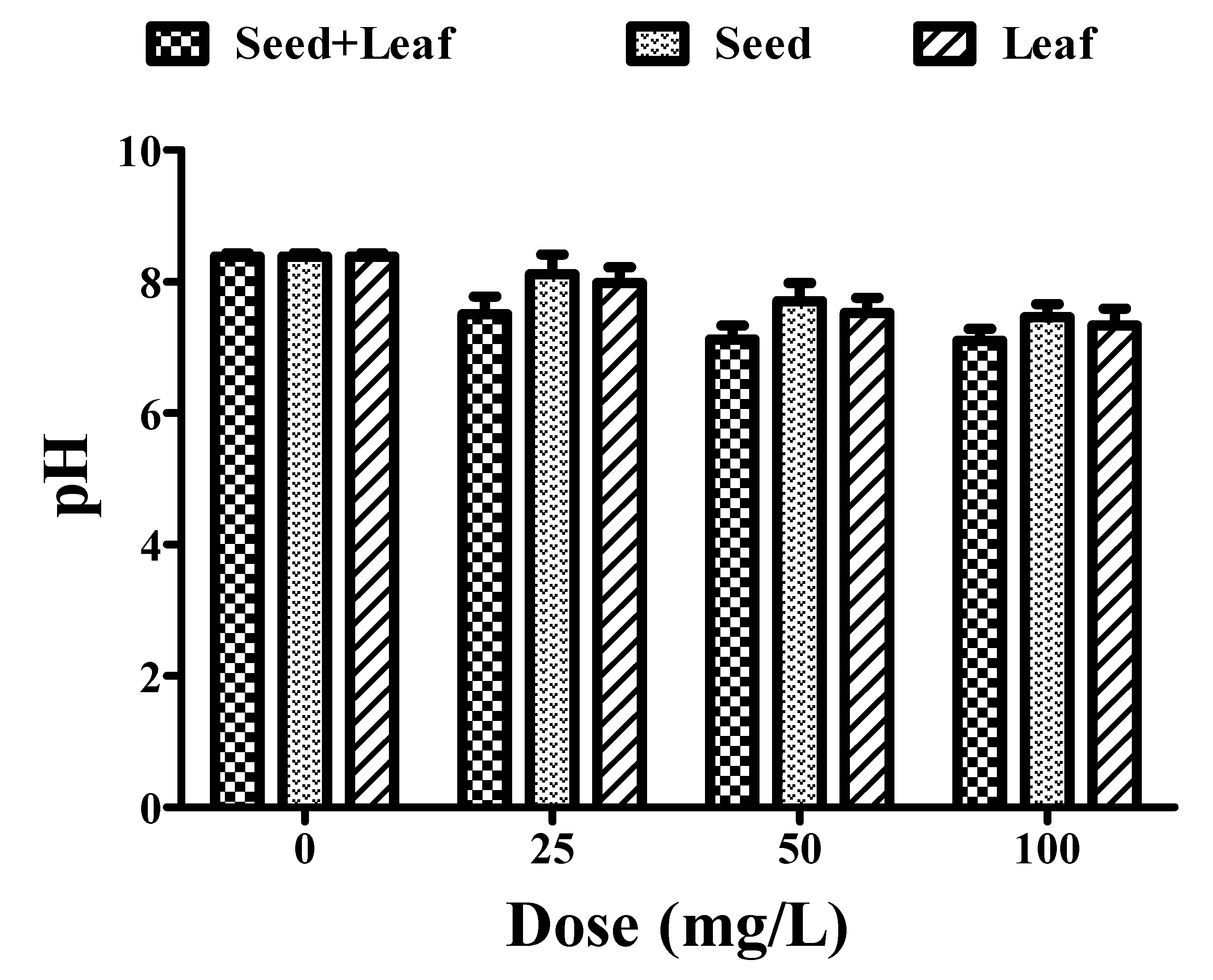
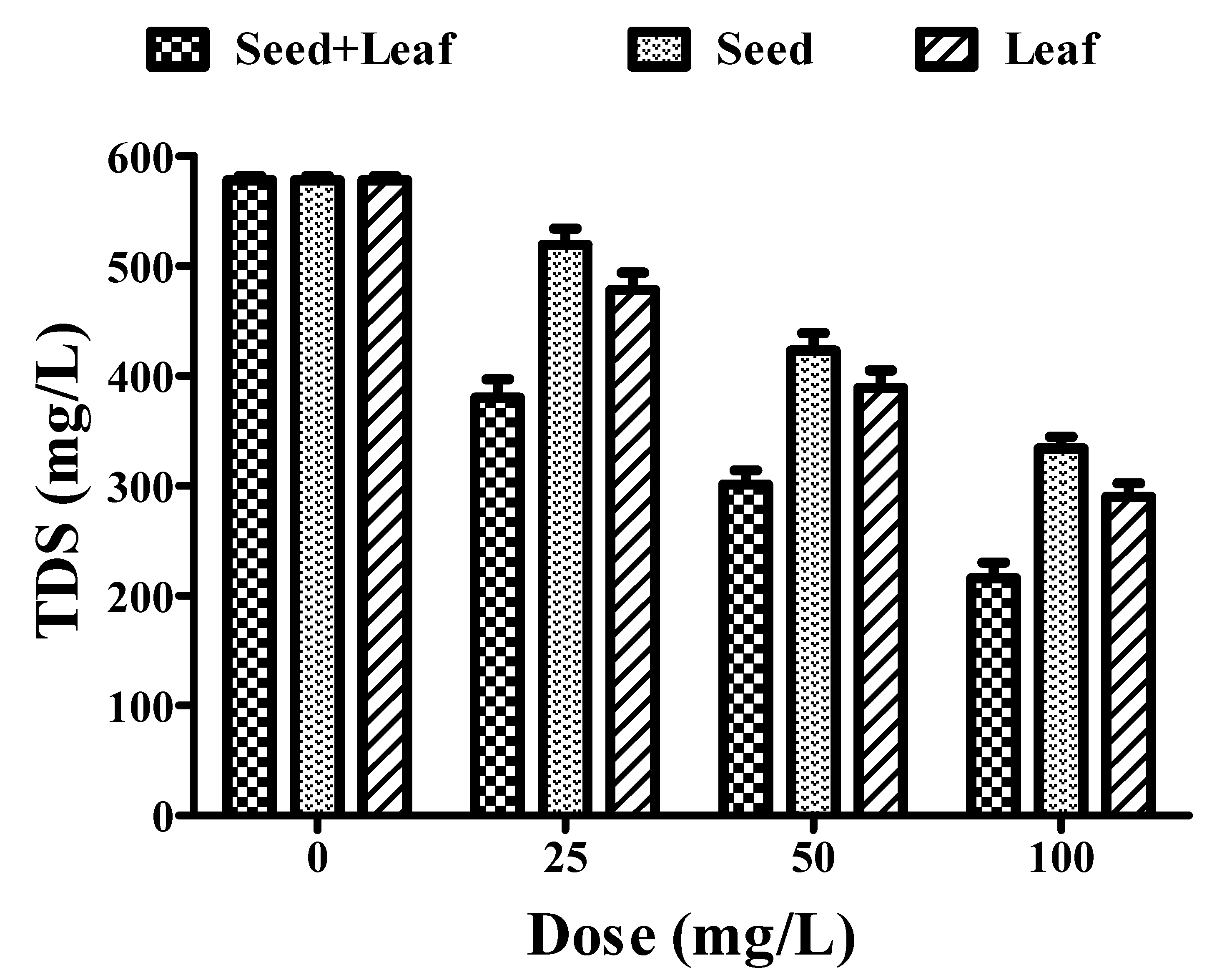
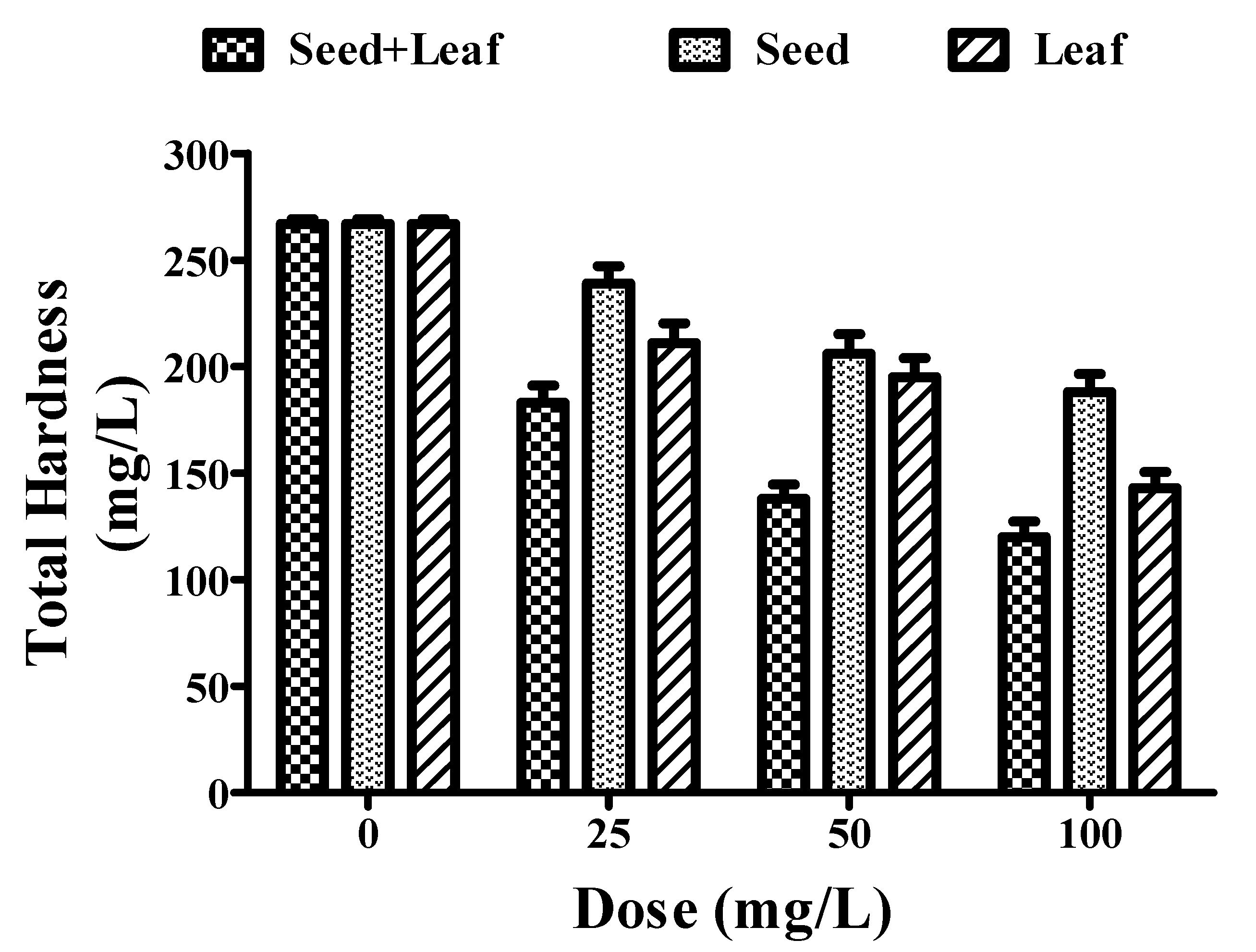
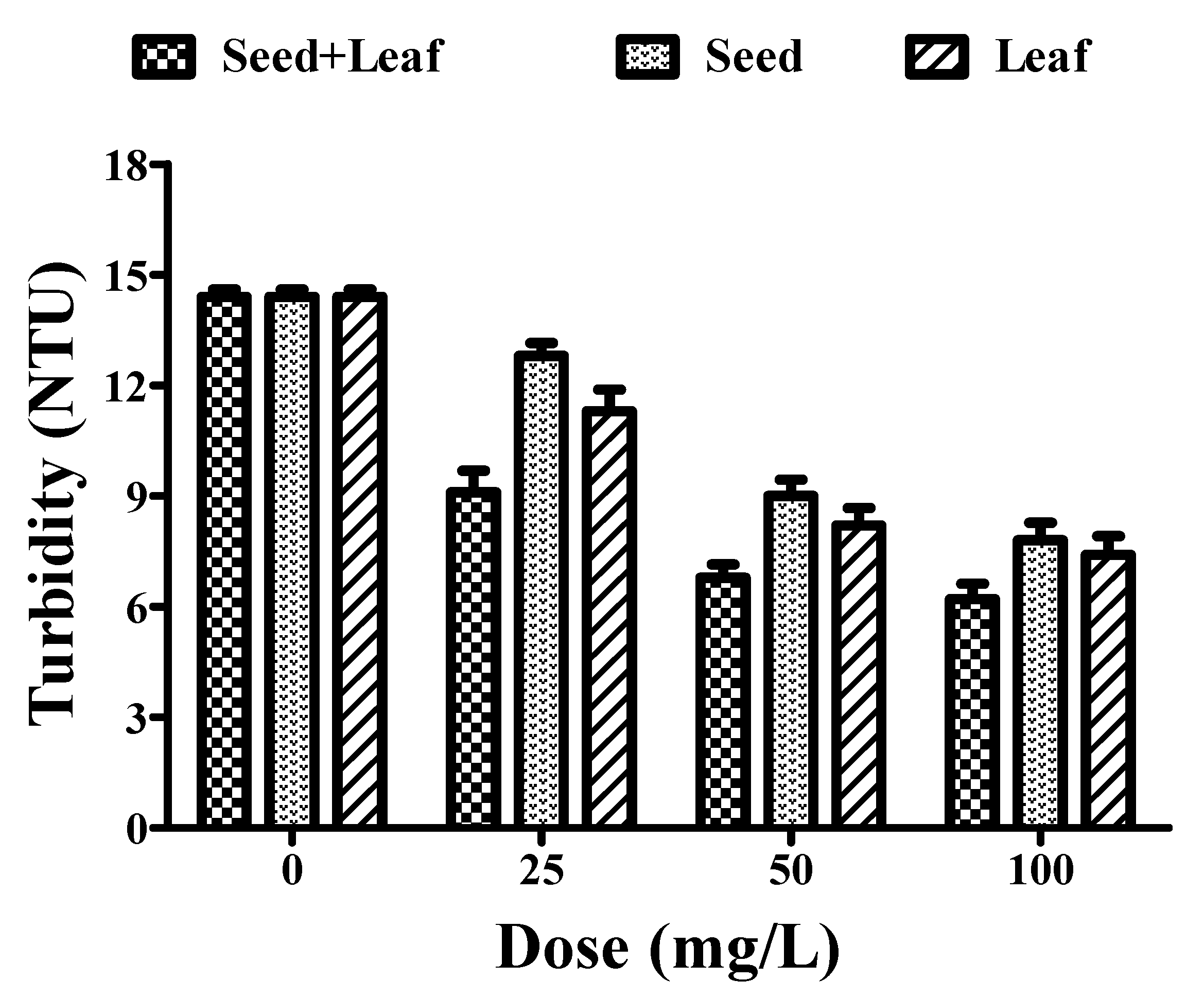
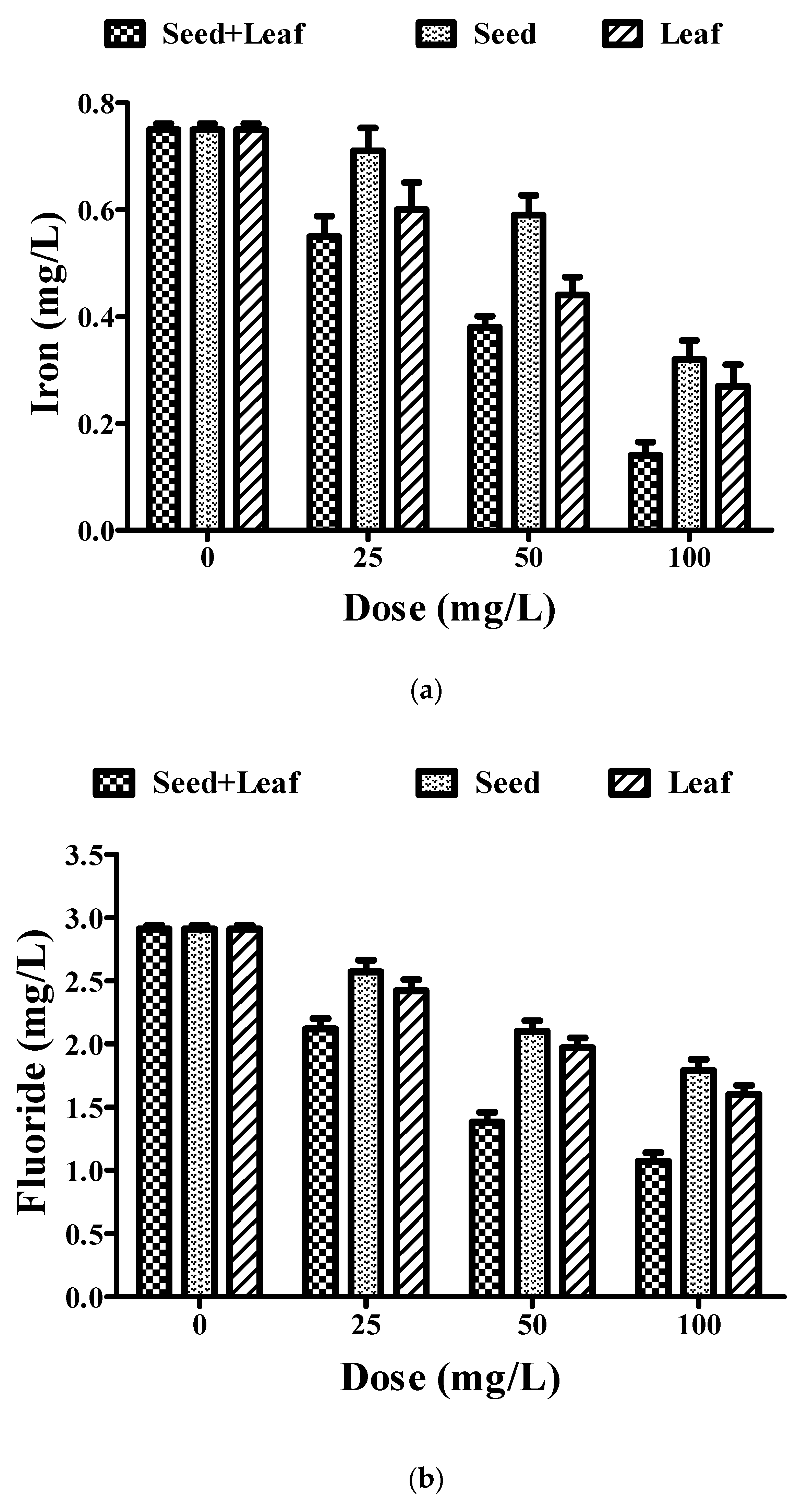
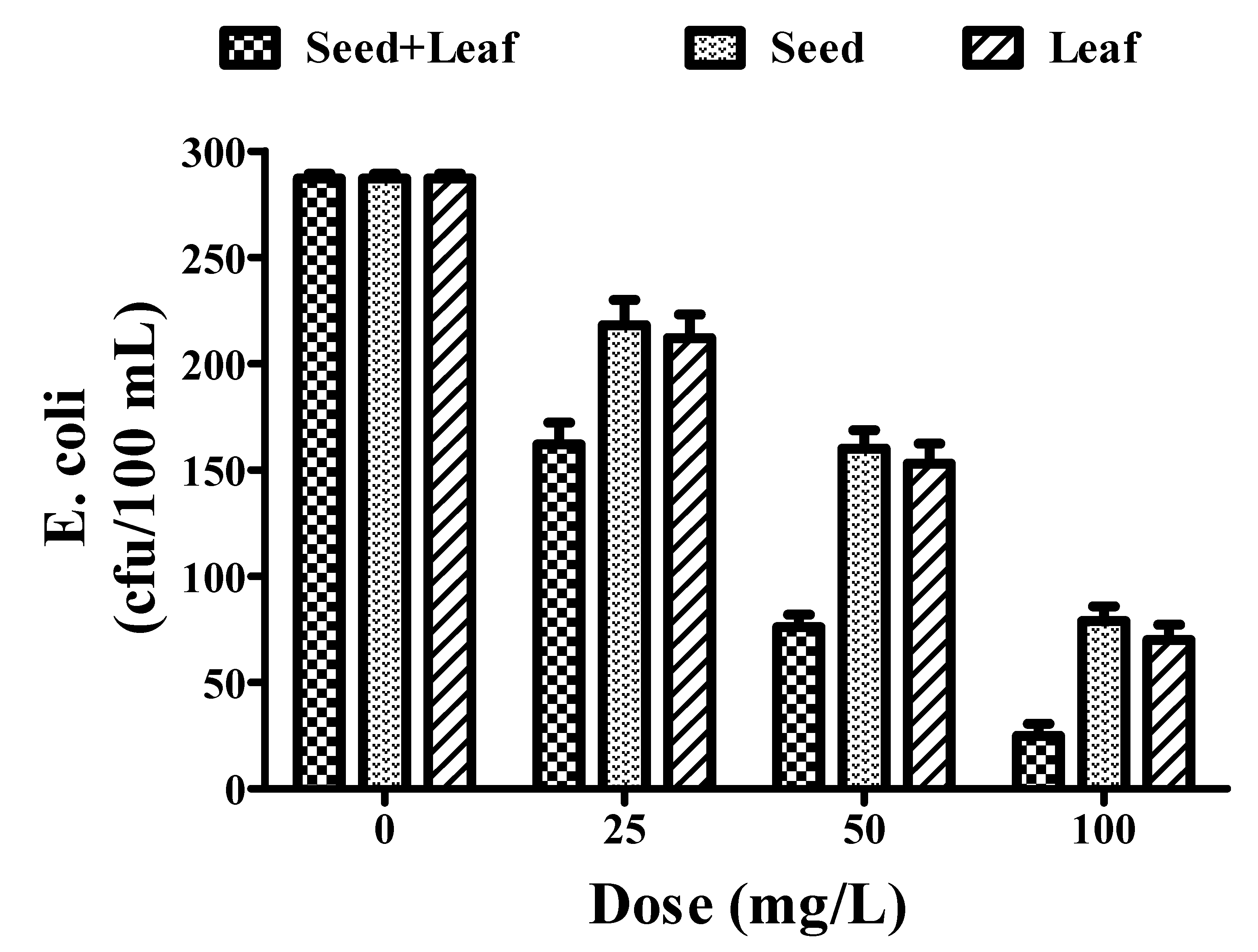
| S. No. | Water Quality Parameters | Untreated Water | Treated Water | ||||||||
|---|---|---|---|---|---|---|---|---|---|---|---|
| 25 mg/L | 50 mg/L | 100 mg/L | |||||||||
| S + L a | S b | L c | S + L | S | L | S + L | S | L | |||
| 1 | pH | 8.38 ± 0.03 | 7.50 ± 0.23 | 8.11 ± 0.20 | 7.98 ± 0.18 | 7.12 ± 0.28 | 7.70 ± 0.18 | 7.52 ± 0.193 | 7.10 ± 0.22 | 7.46 ± 0.21 | 7.33 ± 0.310 |
| 2 | TDS * (mg/L) | 578.00 ± 3.11 | 380.00 ± 10.99 | 519.00 ± 12.99 | 478.00 ± 11.98 | 301.00 ± 13.98 | 423.00 ± 10.98 | 389.00 ± 11.12 | 216.00 ± 11.34 | 334.00 ± 14.60 | 290.00 ± 14.29 |
| 3 | Hardness (mg/L) | 267.00 ± 3.11 | 183.00 ± 6.99 | 239.00 ± 9.23 | 211.00 ± 9.87 | 138.00 ± 9.10 | 206.00 ± 7.98 | 195.00 ± 7.72 | 120.00 ± 7.21 | 188.00 ± 7.60 | 143.00 ± 9.10 |
| 4 | Turbidity (NTU #) | 14.40 ± 0.12 | 9.10 ± 0.68 | 12.80 ± 0.52 | 11.30 ± 0.46 | 6.78 ± 0.43 | 9.00 ± 0.48 | 8.20 ± 0.36 | 6.20 ± 0.39 | 7.80 ± 0.36 | 7.40 ± 0.40 |
| 5 | Fluoride (mg/L) | 2.91 ± 0.02 | 2.12 ± 0.09 | 2.57 ± 0.08 | 2.42 ± 0.07 | 1.38 ± 0.10 | 2.10 ± 0.06 | 1.97 ± 0.06 | 1.07 ± 0.07 | 1.79 ± 0.08 | 1.60 ± 0.09 |
| 6 | Iron (mg/L) | 0.75 ± 0.02 | 0.55 ± 0.09 | 0.71 ± 0.08 | 0.60 ± 0.07 | 0.38 ± 0.10 | 0.59 ± 0.06 | 0.44 ± 0.06 | 0.14 ± 0.07 | 0.32 ± 0.08 | 0.27 ± 0.09 |
| 7 | E. coli (cfu $/100 mL) | 287.00 ± 0.98 | 162.00 ± 10.10 | 218.00 ± 7.89 | 212.00 ± 9.12 | 76.00 ± 8.78 | 160.00 ± 8.98 | 153.00 ± 9.11 | 25.00 ± 6.99 | 79.00 ± 8.19 | 70.00 ± 6.12 |
© 2020 by the authors. Licensee MDPI, Basel, Switzerland. This article is an open access article distributed under the terms and conditions of the Creative Commons Attribution (CC BY) license (http://creativecommons.org/licenses/by/4.0/).
Share and Cite
Alam, M.W.; Pandey, P.; Khan, F.; Souayeh, B.; Farhan, M. Study to Investigate the Potential of Combined Extract of Leaves and Seeds of Moringa oleifera in Groundwater Purification. Int. J. Environ. Res. Public Health 2020, 17, 7468. https://doi.org/10.3390/ijerph17207468
Alam MW, Pandey P, Khan F, Souayeh B, Farhan M. Study to Investigate the Potential of Combined Extract of Leaves and Seeds of Moringa oleifera in Groundwater Purification. International Journal of Environmental Research and Public Health. 2020; 17(20):7468. https://doi.org/10.3390/ijerph17207468
Chicago/Turabian StyleAlam, Mir Waqas, Pratibha Pandey, Fahad Khan, Basma Souayeh, and Mohd Farhan. 2020. "Study to Investigate the Potential of Combined Extract of Leaves and Seeds of Moringa oleifera in Groundwater Purification" International Journal of Environmental Research and Public Health 17, no. 20: 7468. https://doi.org/10.3390/ijerph17207468
APA StyleAlam, M. W., Pandey, P., Khan, F., Souayeh, B., & Farhan, M. (2020). Study to Investigate the Potential of Combined Extract of Leaves and Seeds of Moringa oleifera in Groundwater Purification. International Journal of Environmental Research and Public Health, 17(20), 7468. https://doi.org/10.3390/ijerph17207468









